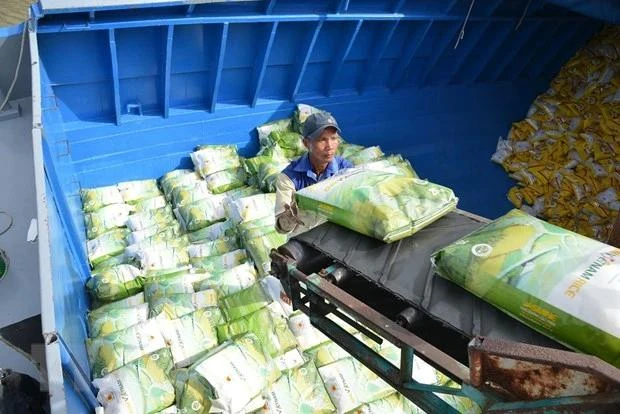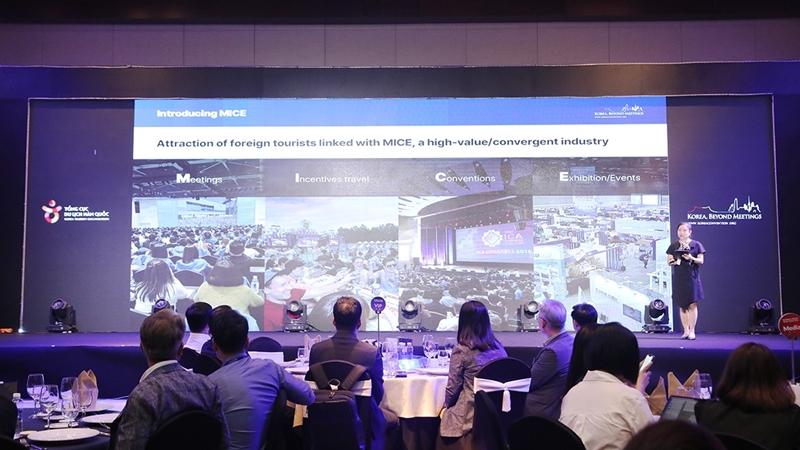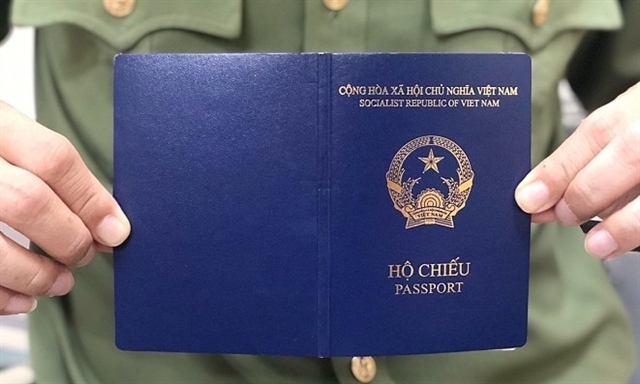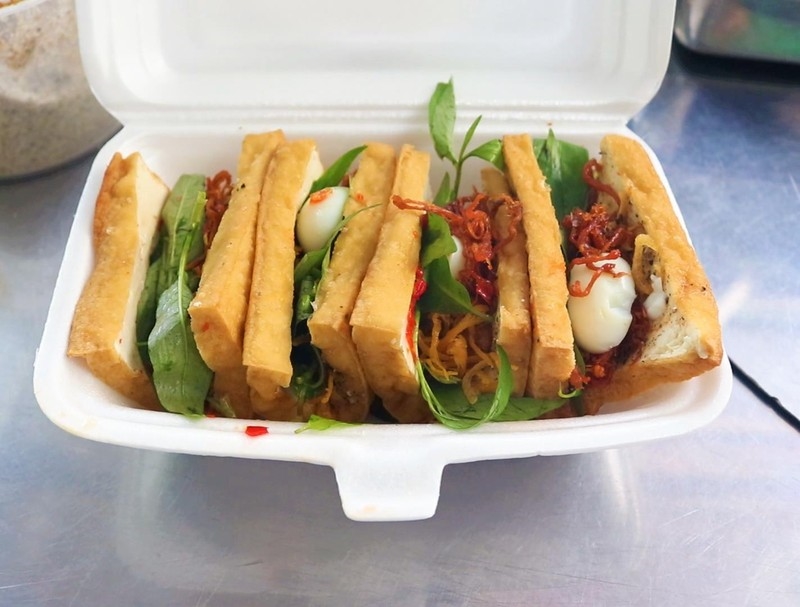 |
| A corner of the Vietnam - Singapore Industrial Park in Tan Uyen town, the southern province of Binh Duong (Photo: VNA) |
The disbursed investment was recorded at over 12.55 billion USD, up 8.4% as compared to the same time last year.
Foreign investors injected 10.76 billion USD in 1,816 new projects, rising 35.6% and 11.6%, respectively.
Meanwhile, 734 projects had their capital adjusted up with a total amount of more than 10.76 billion USD, down 0.3% in the project number, and up 19.4% in capital year-on-year.
Capital contributions and share purchases fell 45.2% to 2.27 billion USD.
The agency said that foreign investors funneled their money in 18 out of 21 economic sectors, with the processing and manufacturing industry attracting the largest share of over 12.65 billion USD, or 70.3% of the total. The realty sector came second with more than 2.87 billion USD, wholesale and retail sale industry third with nearly 740.5 million USD, and professional activities and science-technology fourth with over 490.6 million USD.
Registering 6.52 billion USD, Singapore was the biggest investor among 91 countries and territories investing in the nation in the reviewed period, followed by China’s Hong Kong, Japan, China and the Republic of Korea.
The foreign investors landed their capital in 48 cities and provinces across the nation. Bac Ninh attracted the largest amount of foreign capital with nearly 3.2 billion USD while in the second and third places were Quang Ninh and Ho Chi Minh City, luring over 1.56 billion USD and 1.55 billion USD, respectively.
The foreign-invested sector enjoyed a trade surplus of around 27.9 billion USD (including crude oil), and contributed greatly to the nation’s trade surplus of 12.4 billion USD during the seven-month period.
As of July 20, Vietnam was home to 40,777 valid foreign projects with total registered capital of 487 billion USD. Some 309.7 billion USD was disbursed by the time.
Vietnam maintains top position among Singapore’s rice supplier
Vietnam continued to be the top source of rice in Singapore, with 73.4 million SGD (over 54.6 million USD) worth of rice shipment to the nation during January-June, a year-on-year surge of 54.67%, reported VNA.
 |
| Vietnam has been the top source of rice in Singapore. (Photo: VNA) |
Statistics from the Vietnam Trade Office in Singapore showed that export turnover of glutinous rice to the city-state rose more than five fold to 8.9 million SGD, broken rice shot up 187.3% to 1.5 million SGD, and milled or husked fragrant rice soared 161.35% to 27.27 million SGD.
Meanwhile, earnings from white rice witnessed a slight increase of 1.91% to 34.5 million SGD, while revenue from regular brown rice fell 51.2% to 102,000 SGD.
Vietnamese rivals, Thailand and India, sold some 70.73 million SDG and 58.41 million SGD worth of rice to the nation.
Singapore’s increasing rice import is attributable to India’s rice export ban, and the country’s tourism recovery. During the six-month span, it spent nearly 224.5 million SGD on rice purchase, up 13.62% year-on-year.
According to Vietnamese trade counseller Cao Xuan Thang, major competitors of Vietnam in the Singaporean market, namely Thailand, India and Japan, have paid due attention to enhancing their product images, while Vietnamese firms have had no large-scale promotion campaign.
He stressed that Vietnamese exporters must strive to improve their competitive edge as well as rice quality, given the strict management of the rice market by the Singaporean government.
The signing of agreements and commitments at the governmental level regarding rice supply will contribute to stabilising Vietnamese rice shipment to Singapore, he suggested.
In the first three months of this year, Vietnam for the first time surpassed India and Thailand to become the largest rice exporter to Singapore by shipping 36.15 million SGD worth of rice, an increase of 80.46% over the same period in 2023.
RoK promotes MICE tourism in Da Nang, Ho Chi Minh City this August
A tourism promotion programme is set to be launched in Da Nang and Ho Chi Minh City this August as part of efforts to introduce popular destinations and unique tourism products in the Republic of Korea (RoK), with a specific focus on meetings, incentives, conferences and exhibitions (MICE) tourism, reported VOV.
 |
| Delegates attending Korea MICE Roadshow held in Vietnam last year. (Photo courtesy of the Vietnam National Authority of Tourism) |
The event, to be organised by the Korea Tourism Organization (KTO), is expected to attract around 150 delegates. It is scheduled to take place at Ariyana Convention Centre in Da Nang on August 7 before heading to Nikko Saigon Hotel in Ho Chi Minh City on August 9.
Representatives of the Vietnam National Authority of Tourism, the Vietnam Tourism Association, international airlines and tour operators, as well as both Vietnamese and foreign media outlets will be in attendance at the function.
According to the KTO, the Korean Government declared 2023 and 2024 to be the Visit Korea Year to boost visitor numbers. In response, the KTO has worked out tourism promotion events in Asian countries, especially Vietnam.
Many promotions have also been planned this year in a bid to attract more Vietnamese tourists.
The RoK is currently viewed as a major MICE tourism hub in Asia thanks to its high-quality infrastructure system which can be found in many cities, including Seoul, Busan, Jeju, Incheon, Gyeonggi, and Gangwon.
In the first quarter of the year, nearly 120,000 Vietnamese tourists travelled to the RoK, an annual increase of 8.5%, respectively, from the same period in 2019 before the outbreak of the COVID-19 pandemic.
Last year witnessed the RoK attract more than 420,000 tourists from Vietnam, thereby making it the largest tourist source of the RoK in Southeast Asia and the fifth largest source of tourists for the North-East Asian country worldwide.
Meanwhile, the RoK remained the largest source market for Vietnamese tourism as 3.6 million Korean visitors travelled to the Southeast Asian nation last year.
Vietnamese passport maintains 88th position in global index
The latest report compiled by the Henley Passport Index indicates that Vietnam retained its 88th position in the rankings of the world’s most powerful passports this year, reported VOV.
 |
| Photo for illustration (Source: VOV) |
According to the report, which scores passports based on the number of destinations that the holder can access visa-free, Vietnamese passports enable visa-free travel to 51 out of a total of 227 destinations globally.
In Southeast Asia, the Vietnamese passport is more powerful than those of both Laos, 90th globally; and Myanmar, 92nd globally.
Singapore boasts one of the most powerful passports in the world as holders are able to enter 195 destinations globally without a visa.
The Malaysian passport is the 12th most powerful in the world, with visa-free access to 182 destinations; while the Thai passport ranked in 60th place. Its citizens are allowed to visit 82 countries without needing to apply for a visa.
Elsewhere, France, Italy, Germany, Japan, and Spain all shared second position on the list as their citizens are able to visit 192 countries and territories without needing a visa.
In contrast, the world’s weakest passports are those from poor countries mired in conflict, including the likes of Syria, Iraq, Yemen, Pakistan, and Afghanistan. Passport holders from these countries are only able to visit between 26 and 33 other countries without needing a visa.
With historical data spanning the past 19 years, the Henley Passport Index is the only one of its kind based on exclusive data compiled by the International Air Transport Authority (IATA).
The index includes 199 different passports and 227 different travel destinations. Updated monthly, the Henley Passport Index is considered to be the standard reference tool for global citizens and sovereign states when assessing where a passport ranks on the global mobility spectrum.
Fried tofu sandwich: A captivating street snack in Ho Chi Minh City
Fried tofu sandwiches have captivated street-food lovers in Ho Chi Minh City, with their irresistible combination of soya and spices - a remarkable accomplishment for a relatively new entry to Vietnam’s vast array of street food, reported VNS.
 |
| Fried tofu sandwich: A captivating street snack in Ho Chi Minh City |
The dish uses tofu bars that are lightly fried beforehand giving an appetising golden glow and allowing them to be preserved longer.
For the dish, the tofu bars can be steamed or deep-fried to a crisp.
Other ingredients include chilli and salt, as well as coriander, a common herb used for salads, fresh spring rolls and many other Vietnamese dishes. A squeeze of lime or kumquat is added to give the dish a light sour tang.
A tofu bar is sliced open in the middle and ingredients are simply added before the two tofu slices are closed together, forming a sandwich.
A bite of the sandwich quickly reveals why this dish has become so popular. The soft-textured tofu is light yet rich with soya flavour, and the spicy chilli and salt really make the tofu stand out.
The light sour touch of lime or kumquat stimulates the tongue, while the aromatic coriander lends tofu sandwiches a refreshing taste.
Some vendors serve additional toppings, such as meat jerky and eggs, as well as a dipping sauce to go with the sandwiches./.